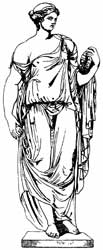Flora

The Roman goddess of flowers and spring. The writers, whose object it was to bring the Roman religion into contempt, relate that Flora had been, like Acca Larentia, a courtesan, who accumulated a large property, and bequeathed it to the Roman people, in return for which she was honored with the annual festival of the Floralia (240 BCE).1 But her worship was established at Rome in the very earliest times, for a temple is said to have been vowed to her by king Tatius,2 and Numa appointed a flamen to her. A second temple was dedicated to her in 238 BCE, on advice of the Sibylline books.
The resemblance between the names Flora and Chloris led the later Romans to identify the two divinities. Her temple at Rome was situated near the Circus Maximus,3 and her festival was celebrated from the 28th of April till the first of May, with extravagant merriment and lasciviousness.
Favonius, the west wind, is mentioned as her lover or husband.
❧
Iconography
In Roman art she is portrayed as a young maiden wearing garlands, such as on coins. A statue of Flora was located in the Caracalla Therme at Rome. In later times the persona of Flora has inspired many painters, among which Gérard and Rembrandt.
References
Notes
Source
- Smith, William. (1870). Dictionary of Greek and Roman Biography and Mythology. London: Taylor, Walton, and Maberly.
This article incorporates text from Dictionary of Greek and Roman Biography and Mythology (1870) by William Smith, which is in the public domain.